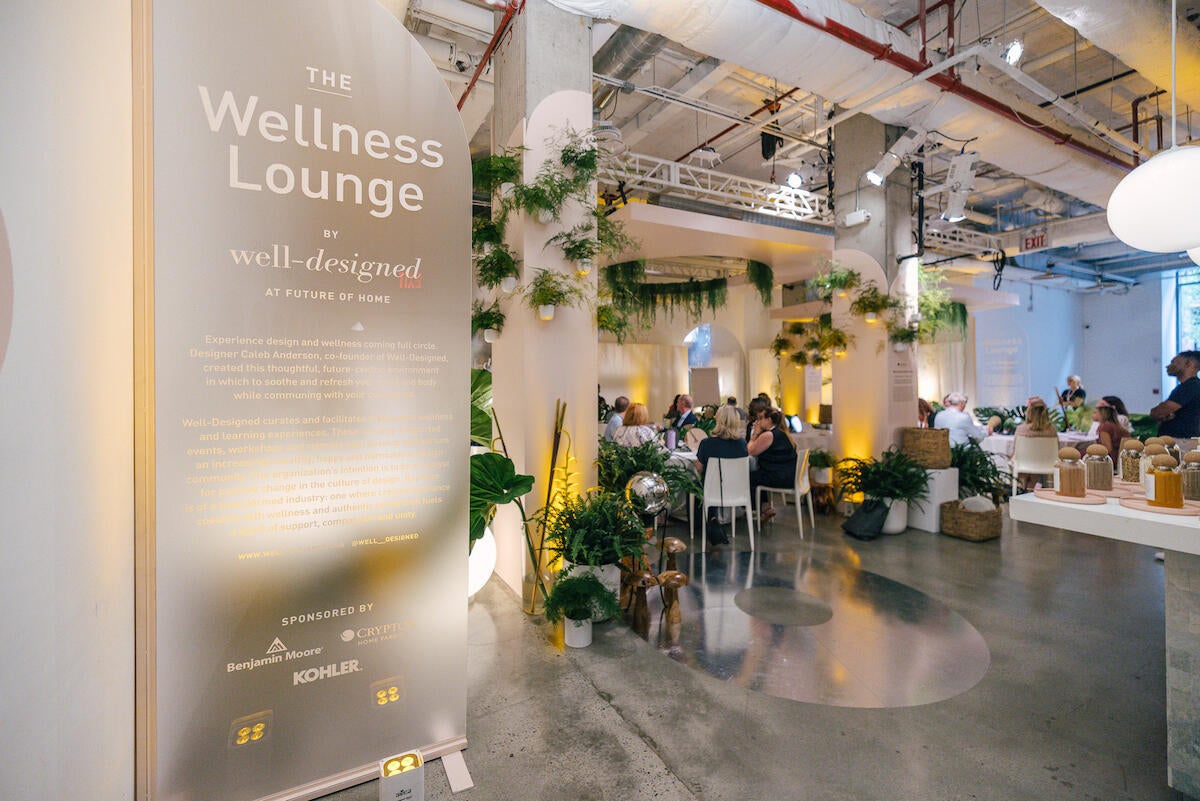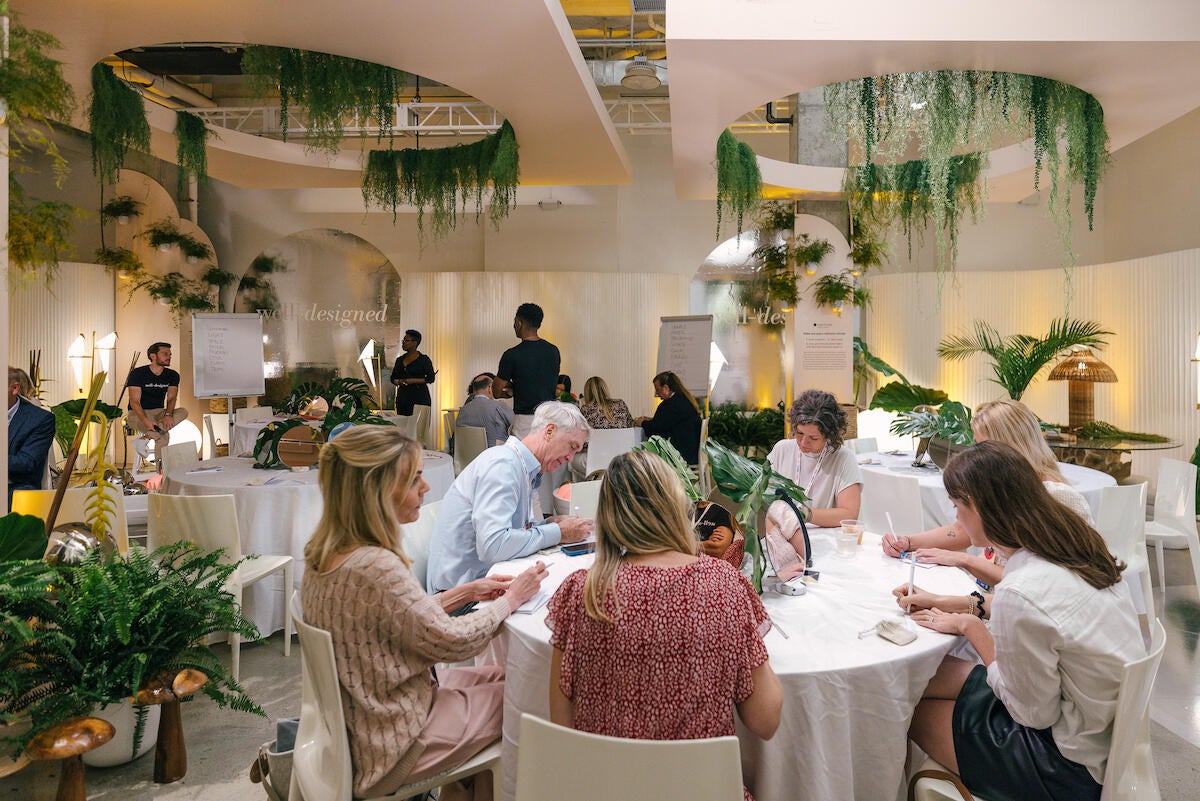When Caleb Anderson and DeAndre DeVane took the stage at Future of Home on Monday, their message was clear: Wellness is more than just a trendy term—it’s a way of life. The co-founders of Well-Designed—a trade organization that aims to facilitate wellness-centric learning experiences through industry-supported events—debuted their project at the two-day conference, hosting everything from a panel discussion to workshops and a lounge equipped with an Ayurvedic tea bar and a DIY aromatherapy station. “Wellness is about being centered and always having a space within yourself that you can come back to,” Anderson tells Business of Home. “It requires work, time, effort and practice, but it’s crucial to our personal lives and the industry as a whole.”
The panel, titled “Wellness in Design,” united Anderson, DeVane and Amanda Hilton, wellness educator and founder of The Simply Well, to discuss the importance of implementing a healthier, holistic framework in the design community. “I love design, and like me, most people in this industry love being creative,” said Anderson during the panel conversation. “However, somewhere along the line, we often lose sight of that joy because of daily stress and the demands of the job.”

Based on a survey conducted by Well-Designed, 84 percent of designers report anxiety and stress as a significant problem in the design profession. “Chronic stress increases cortisol production, which over time can cause areas of the brain to shrink, particularly the area associated with self-control and memory,” said Hilton.
To foster a better work-life balance, Hilton said it’s crucial to incorporate self-care and stress-relieving activities into your daily routine. “When you practice de-stressing regularly, you retrain your brain to come back down to equilibrium whenever you’re under stress.”
Changing your habits won’t just improve personal quality of life; it can also prompt a trickle-down effect that impacts the community as a whole. “When designers have a healthy mindset, it positively affects everyone around them, including clients, partners and staff,” Anderson tells BOH. “If I’m not taking care of my emotional, physical and spiritual self, I’m not living up to my full potential, nor am I giving others everything that I can.”
By prioritizing mental health, Anderson believes you can become more efficient, in turn crafting better interiors. “When you hold space for yourself, you learn how important it is to create spaces where others can practice being more mindful,” he says. “The end game is designing healthy environments that elevate the human experience.”

The Wellness Lounge by Well-Designed at the Future of Home conference provided a compelling case in point. Outfitted in calming hues, sumptuous textures and a slew of dreamy hanging plants, Anderson designed the area as an escape. “I wanted to create a sensory space where visitors instantly felt transported,” he says.
Aesthetically, that meant employing a harmonious mix of mirrored spheres, ambient globe lights, curvilinear chairs and lots of biomorphic motifs (including mushroom- and bird-shaped table lamps). “The design marries elements of modernism, futurism and surrealism with nature,” says Anderson. “The mirrored surfaces evoke self-reflection, and the glowing orbs symbolize what I want Well-Designed to be: a light in the industry.”
The lounge also provided a thoughtful backdrop for the organization’s brand partners to showcase their health-focused products. Anderson painted the walls in Love & Happiness by Benjamin Moore, a soothing shade of soft pink that serves as the signature hue of Well-Designed. Nestled inside a trio of reflecting ponds, Kohler’s Composed Tall bathroom sink faucets in polished chrome offered guests a sparkling surface to gaze upon. Even the round seat cushions—placed in baskets around the lounge for a quick place to perch—were upholstered in Kravet’s Namaste Boucle in Oreo, which uses Crypton Home’s Celliant-powered performance fabric to transform body heat into healing infrared energy, with clinically proven benefits such as improved circulation, faster recovery and better sleep. “This is a space that delights the senses,” says Anderson.

Throughout both days of the event, the lounge was home to an array of interactive experiences. In addition to the Health-Forward bar that served antioxidant-rich coffees, teas, elixirs and small bites—hand-made by a holistic chef, no less—Well-Designed installed an aromatherapy station, where visitors could craft their own mood-lifting essential oil blend. “They are a reminder to take a moment to reset and breathe in the oils before the next phone call or meeting,” says Anderson. “We’re trying to teach lessons that are applicable to designers’ everyday lives.”
Lessons also included a grounding sound-bath session complete with vibrating bowls and vocalizations by Kamila Smith, and a desk yoga demonstration where participants learned quick and effective stretches to use throughout the workday. “These are more than just wellness activities,” Anderson says. “These are actionable techniques that are tailored to the architecture and design audience.”

On Tuesday afternoon, Well-Designed hosted its inaugural workshop, Mirrors, providing participants with a miniversion of its full-day offerings. Experts guided industry pros—including Margie Lavender, principal at Ike Kligerman Barkley; Paula Smith, marketing director at Fisher & Paykel; and Annie Shafer, campaigns and partnerships manager at Kohler—through deep breathing and visualization exercises, writing prompts and group discussions. “We want to offer a healthy alternative to typical networking events,” Anderson says. “These workshops allow members of the community to connect on a deeper level and understand each other in a way that far surpasses small talk.”
The end game is an ecosystem that promotes a more holistic approach to design industry relationships, networking and work as a whole. “This is an opportunity to choose a different path,” said DeVane during the workshop. “When you operate from a sense of abundance—not scarcity—the possibilities are endless.”



























